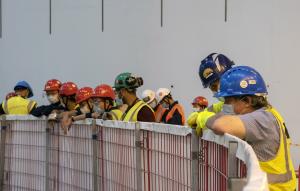Summer jobs
Massive, intense and spectacular
7 Sep 2020
The 2020 summer months saw some of the most massive, intense and spectacular activities in ITER Project history.
Teams were exceptionally busy during the summer months, which saw some of the most massive, intense and spectacular activities in ITER Project history. In this picture, Tokamak Assembly Coordinator Bob Shaw and Jens Reich, head of the Tokamak Assembly Division (right), share a light moment just as the cryostat lower cylinder is safely positioned at the bottom of the assembly pit.
July ended with heads of state and world dignitaries virtually gathered in the ITER Assembly Hall to celebrate the launch of assembly operations. August began with the arrival from Korea of the first vacuum vessel segment—an alien-looking, D-shaped chunk of steel which, once welded to 8 other similar 40-degree segments, will form the toroidal chamber where fusion reactions will occur.
By the end of the month, the time had come to move the cryostat lower cylinder out of its protective cocoon and into the Assembly Hall. The operation was spectacular: manufactured in India and assembled and welded on site, the lower cylinder is a giant steel ring, 6 centimetres thick, 10 metres high, and 30 metres in diameter—and the doors into the building offered just enough clearance for it to pass.
Once inside, and after a few days of preparation and tests, the 375-tonne component was lifted, moved along the entire length of the assembly theatre and delicately inserted into the Tokamak assembly pit. The operation on 31 August was both similar and different (and, at times, even more challenging) than the one on 26 May, when the base section of the cryostat was positioned at the bottom of the pit.
Four days into September, a fourth toroidal field coil (TF11, from Europe) arrived on the ITER site. Travelling along the ITER Itinerary now are two semi-circular magnet feeders that left Shanghai late May and arrived in France on 7 July. Next week, logistics teams are expecting vacuum vessel thermal shielding from Korea, followed shortly by the first batch of cryostat top lid segments from India.
One by one, the pieces of the giant ITER Erector set are being delivered to the construction site. Ten years to the month after the beginning of building construction and five years before the production of ITER's First Plasma, assembly has begun in earnest.


